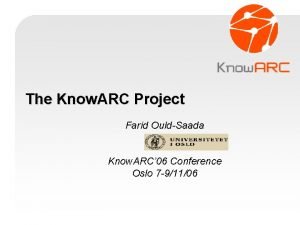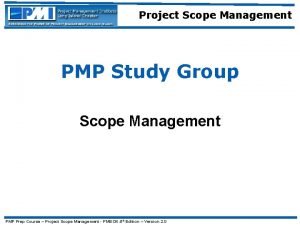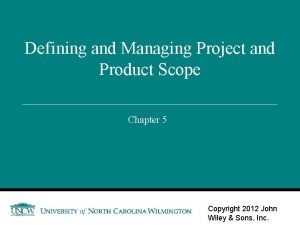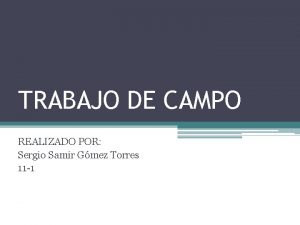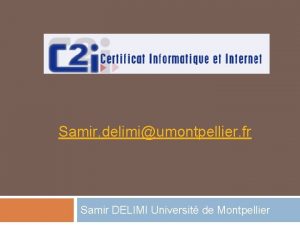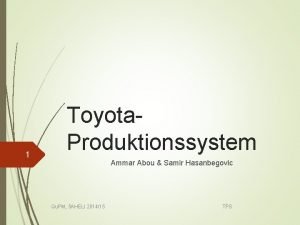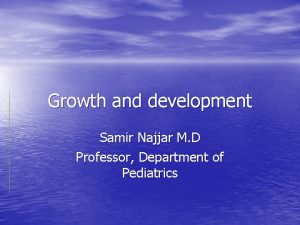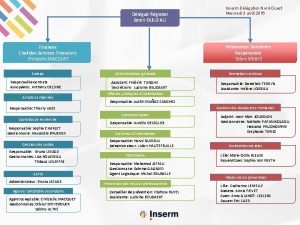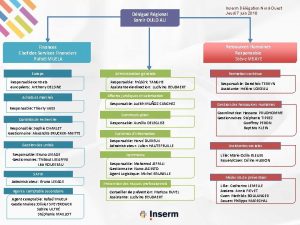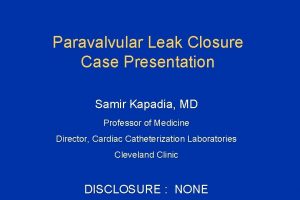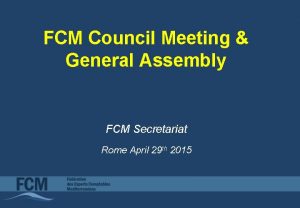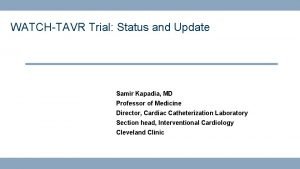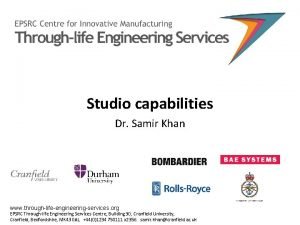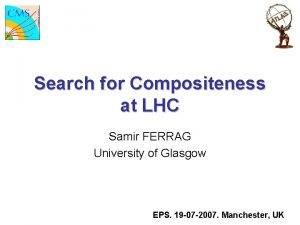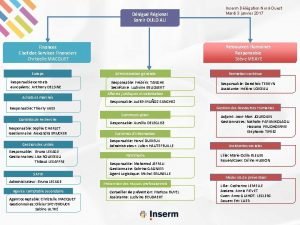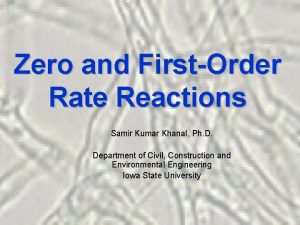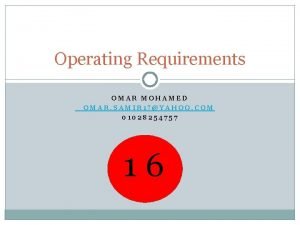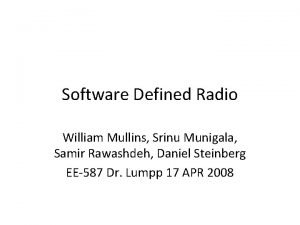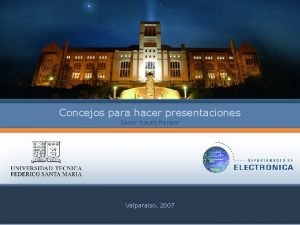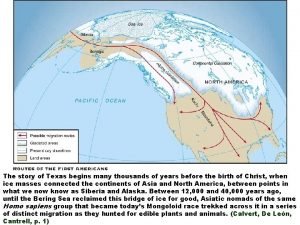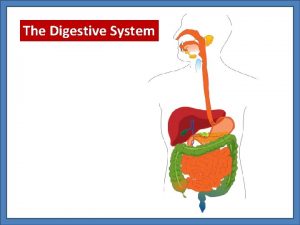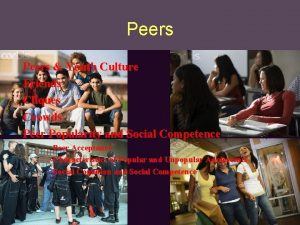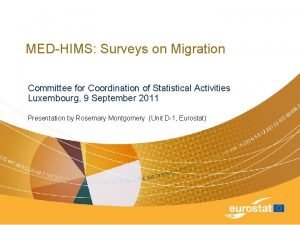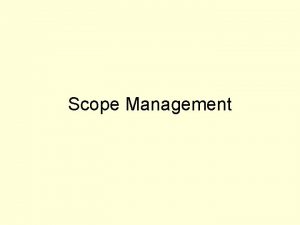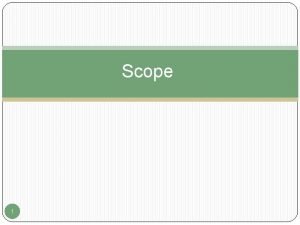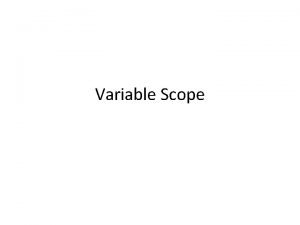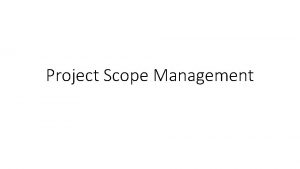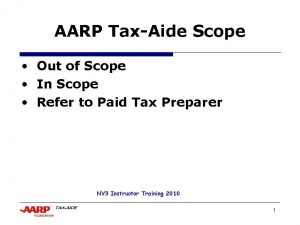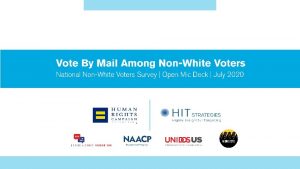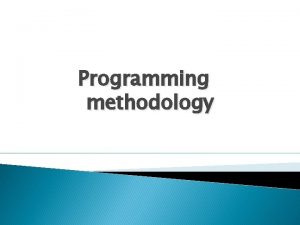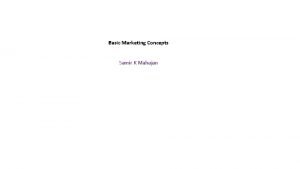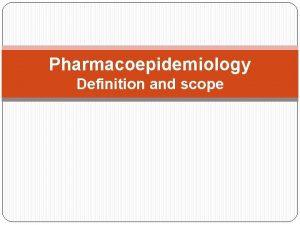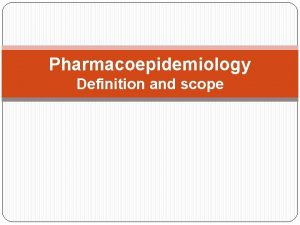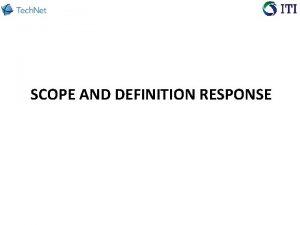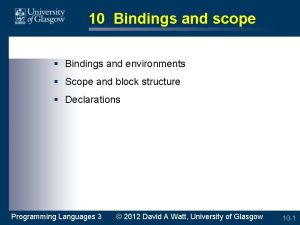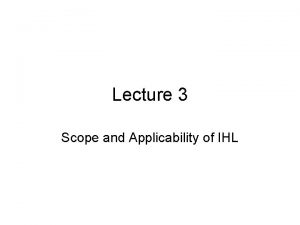MEDHIMS Scope and Methodology Samir Farid MEDHIMS Chief



















































- Slides: 51

MED-HIMS Scope and Methodology Samir Farid MED-HIMS Chief Technical Adviser Giambattista Cantisani MED-HIMS Regional Activities Coordinator International Workshop on Methodological Challenges for the Study of Return and Circular Migration Madrid, 22 -23 January 2015

Contents 1. Origin and objectives of MED-HIMS 2. MED-HIMS Instruments 3. MED-HIMS Model Questionnaires 3. 1 The Study Population and Model Questionnaires 3. 2 Concepts and Definitions 3. 3 Eligibility for the Model Questionnaires 4. MED-HIMS Outputs and Examples of Data Utilization 5. Organization and Implementation Modalities 5. 1 The International Level 5. 2 The National Level 6. Concluding Remarks

1. Origin and Objectives of MED-HIMS • The ‘Mediterranean Household International Migration Survey’ (MED-HIMS) is a regional programme of coordinated international migration surveys that aims at collecting reliable and representative data on the determinants and consequences of international migration and mobility in the Middle East and North Africa (MENA) region. 3

• The programme originated in the European Commission’s MEDSTAT Programme in 2008 where 8 countries in the MENA region (namely-Algeria, Egypt, Jordan, Lebanon, Morocco, Palestine, Syria and Tunisia) expressed the need for conducting a household migration survey to overcome the lack of data on international migration from and within the region. 4

• MED-HIMS developed into a joint initiative of the European Commission, the World Bank, UNFPA, UNHCR, ILO, IOM and the League of Arab States, and is supported by the MEDSTAT Programme and the Euro-Mediterranean Working Group on Migration Statistics (EMWGMS). 5

• The main objectives of MED-HIMS are: (i) to study the recent trends, causes, determinants, dynamics and consequences of international migration and mobility, and the inter-linkages between migration and development; and (ii) to explore scenarios for closer cooperation in the area of migration and development between the MENA sending countries and the main receiving countries. 6

2. MED-HIMS Instruments • The MED-HIMS aims to establish internationally validated guidelines for the design and implementation of specialized household surveys on international migration and to develop standard concepts and procedures for the study of the determinants and consequences of international migration and mobility using survey data. 7

• The MED-HIMS instruments are designed for use in specialized household migration surveys and aim to: – capture current and recent developments in international migration and mobility, and – provide estimates with acceptable precision for key international migration practices and intentions. 8

• The MED-HIMS instruments include the following set of manuals: ü ü ü Manual 1: Model Questionnaires Manual 2: Survey Design and Organization Manual 3: Instructions to Supervisors Manual 4: Instructions to Interviewers Manual 5: Sample Design Manual 6: Data Dictionary and Recode Specifications ü Manual 7: Guidelines for Data Tabulation and Analysis 9

• Already published manuals 10

3. MED-HIMS Model Questionnaires • The Model Questionnaires (MQs) provide the core set of questions needed to obtain population-based estimates of the determinants and consequences of international migration and mobility in the MENA region. • The MQs are designed to be manageable, economical, and to intrude as little as possible on the activities and privacy of families who are interviewed. 11

3. 1 The Study Population and MQs • The target population includes four groups: - current migrants, - return migrants, - non-migrants and potential migrants, and - forced migrants. 12

• The MED-HIMS MQs consist of the following seven questionnaires: ü ü ü MQ-1. Household Questionnaire MQ-2. Individual Questionnaire for Out Migrant MQ-3. Individual Questionnaire for Return Migrant MQ-4. Individual Questionnaire for Non Migrant MQ-5. Individual Questionnaire for Forced Migrant MQ-6. Household Socio-economic and Environmental Characteristics Questionnaire ü MQ-7. Community Characteristics Questionnaire (optional) 13

• The MQs are designed as a series of selfcontained modules, with each module dealing with a particular migration-related topic. • The MQs are thus designed to collect data that are multi-topic, multi-level, retrospective and comparative. 14

• Contents of MQ-3. Individual Questionnaire for Return Migration ü Section 1. Migration History ü Section 2. Return Migrant’s Background ü Section 3. Pre-Migration Situation and Motives for Moving Abroad ü Section 4. Migration Networks and Assistance ü Section 5. Work History ü Section 6. Marital Status and Reproduction ü Section 7. Motives for Return Migration & Perceptions About Migration Experience ü Section 8. Return Migrant Remittances ü Section 9. Health Status 15 ü Section 10. Interviewer’s Observations

3. 2 Concepts and Definitions • The MED-HIMS are specialized single-round cross-sectional surveys with retrospective questioning. • A number of key concepts and definitions are adopted for the purpose of this study. - The concept of the household and the definition of migration are particularly important in this respect. - In addition, the concept of the ‘multi-level eligibility’ has been developed essentially to allow the gathering of data on different migrant groups during different time periods. 16

Household • In MED-HIMS the usual concept of household is extended to include not only those persons who live together and have communal arrangements concerning subsistence and other necessities of life, but also those : - who are presently residing abroad but whose principal commitments and obligations are to that household, and - who are expected to return to that household in the future or whose family will join them in the future. 17

• Therefore, both the household and the shadow household are captured within the definition, a necessary extension for migration studies. • It should be pointed out that a household which has moved abroad as a whole is no longer accessible to be interviewed in the MED-HIMS surveys which cover only sending countries. 18

Migration • Migration is defined as a move from one country in order to go and reside abroad in another country for a continuous period of ‘at least 3 months’, a period in contrast to international recommendations on migration which draw the line at residing abroad for at least one year. 19

• In MED-HIMS, the line has been drawn at ‘more than 3 months’ to allow for the inclusion of seasonal migration across international borders. • Therefore, the migration history module in the survey questionnaires asks for those countries in which someone has lived for ‘more than 3 months. ’ 20

Reference period • MED-HIMS recommends the use of a reference period of ten years preceding the survey. In the MED-HIMS MQs, a reference period starting from “ 1 January 2000” is adopted for the purpose of illustration. 21

Recent and non-recent migrants • A distinction is made between ‘recent’ and ‘non-recent’ international migrants. - Recent migrants are those who have migrated from the country of origin at least once within the ‘reference period’ preceding the survey. - Consequently, a non-recent migrant is someone who has migrated from his/her country of origin at least once, but not within the ‘reference period’. 22

Multi-level eligibility • The concept of ‘multi-level eligibility’ has been introduced to allow the administration of different sets of questions to different groups of migrants. • For example, in the current migrant questionnaire, a set of questions is administered to both recent and non-recent migrants (e. g. questions on the background and remittances of migrants) while a second set of questions is administered to only recent migrants. 23

• In the latter case (i. e. , recent migrants) there are modules gathering data with regard to the ‘first migration’ that occurred within the reference period and other modules gathering data with regard to the ‘country of current residence’ of current migrants or ‘country of last residence’ of return migrants. 24

3. 3 Eligibility for the Model Questionnaires q MQ-1. Household Questionnaire • This questionnaire serves four purposes: (i) to identify the members of the household; (ii) within households, to identify nuclear units, i. e. couples and their own children; (iii) to collect basic demographic information on each of the household members; and (iv) to identify persons eligible for the migrant survey interviews (current, return and forced) and persons eligible for the non-migrant survey interview. 25

q MQ-2. Individual Questionnaire for Out-Migrant • This questionnaire is assigned for every person who used to live in the sample household and who is currently abroad and aged 15 years or more. • This questionnaire will gather data directly from the migrants themselves if they happen to be in the country during the fieldwork period, or indirectly from (proxy) respondents who will be asked to provide information about persons who have moved from their household, to whom they are usually related. 26

q MQ-3. Individual Questionnaire for Return Migrant • This questionnaire is assigned for every member of the household who last returned from abroad to the country of origin since the start of the reference period (e. g. , 1/1/2000) and who was 15 years of age or more on last return. 27

q MQ-4. Individual Questionnaire for Non Migrant • Non-migrant is defined as a member of the household who is: - currently aged 15 -59 years, and - who never moved to another country for more than 3 months. 28

• Selection of non-migrants § Case A: Migrant Households If the household being interviewed has one (or more) out migrant and/or return migrant as well as non-migrants, then one non-migrant is selected randomly (using Kish table) for interview with MQ-4. 29

§ Case B: Non-migrant Households In each enumeration area (cluster) in the survey sample, a sub-sample of non-migrant households is randomly selected, and within each of the thus selected households, one nonmigrant is selected randomly (using Kish table) for interview with MQ-4. 30

q MQ-5. Individual Questionnaire for Forced Migrant • This questionnaire is assigned for every ‘eligible’ non-citizen identified as potential ‘Forced Migrant’ and who is currently 15 years of age or more. • In addition, a targeted sample of around 3000 forced migrants will be selected for interview with the MQ-5 from among the forced migrants registered with UNHCR in each participating country. 31

• A non-citizen aged 15+ years is considered a ‘forced migrant’ if the reason for coming to the survey country is one of the following: - Transit to another country; - Insecurity/war in country of origin; - Persecution related reasons; - Trafficking / Coercion; - To obtain asylum / refugee status. 32

q MQ-6. Household Socio-economic Characteristics Questionnaire • This questionnaire is administered to every household in the sample that has one (or more) out migrant, return migrant, non-migrant or forced migrant. 33

q MQ-7. Community Characteristics Questionnaire (optional) • This questionnaire is used in the sample rural clusters to gather data on the location of the community, social development indicators, principal economic activities, general migration patterns in the community including common attitudes and intentions. 34

4. MED-HIMS Outputs and Examples of Data Utilization The main output data of the MED-HIMS may be summarized as follows: • data on the trends, patterns, determinants and consequences of international migration and the demographic and socio-economic characteristics of migrants and non-migrants; • data on why, when and how migration has occurred and might occur in the future; • data on the processes leading to the decision 35 to migrate;

• data on migration histories and the migration experiences and practices; • data on migration intentions and potential destination; • data on forced migration; • data on pre-migration situation and motives for moving abroad; • data on migration networks and assistance; • data on work history before and after migration; • data on views about social, economic and labour integration and social exclusion; • data on patterns of circular migration; 36

• data on skills and knowledge acquired by migrants; • data on the impact of migration on unemployment and labour dynamics; • data on the pattern of gender-selective migration and the nature of the consequences engendered for women by male outmigration and its impact on children; • data on remittances and their utilization and how they contribute to local development-oriented initiatives and investments in the country; 37

• data on the impact of migration on household economic behaviour and practices; • data on the overall awareness of migration issues and practices; • data on migrants’ future plans; • data on the pattern of return migration and reintegration measures; • data on the qualifications and skills of potential migrants; and • data on the effectiveness of governmental interventions aiming at preventing illegal emigration. 38

One of the aims of the project is to improve data utilization by promoting and encouraging their use by planners, policy makers, and managers of international migration and development programmes. The MED-HIMS output data may be used as evidence based information for: • the establishment of a ‘National Migration Profile’ that will allow to identify certain common characteristics of the migration flows to the main receiving countries; 39

• the development of migration policies and future migration programming; • the development of scenarios to support circular and managed migration, and to design successful action programmes to be coordinated in collaboration with the main receiving countries, particularly the EU countries through the mechanisms of the EU Global Approach to Migration and Mobility; • the identification of priority areas in the field of education and vocational training; 40

• the development of policy measures on recognition of qualifications and the use of transparency tools for the skills of migrants acquired at home and abroad; • the development of policy measures on mitigating the adverse effect of brain drain; • the development of policy measures dealing with forced migration; • achieving better understanding of how remittances can be used to foster local development, and developing relevant policy measures in collaboration with the main 41 receiving countries;

• promoting ‘migration governance’ from a development perspective and improving the understanding of the development and migration nexus; • fostering institutional partnership in the field of migration with the main receiving countries; • assessing the effects of future legislative measures on labour immigration that might be taken by receiving countries in line with their demographic changes. 42

5. Organization and Implementation Modalities 5. 1 The International Level • The major components of the MED-HIMS organization at the international level are: § The Programme Steering Committee (PSC) § The Project Implementation Unit (PIU) 43

• The MED-HIMS PSC is entrusted with the overall substantive guidance and review of the MED-HIMS Programme. • The PSC consists of representatives of the European Commission (Eurostat as PSC Chair), The World Bank, UNFPA, UNHCR, ILO, IOM, the League of Arab States and EMWGMS. 44

• The PIU is responsible for: - managing the MED-HIMS Program; - developing model instruments and tools; - organizing regional workshops; - providing technical assistance at the various stages of the survey; and - carrying out the comparative analysis of national survey results. 45

• The PIU consists of: - Chief Technical Adviser - Regional Activities Coordinator - Sampling Expert - System Analyst - Short-term International Consultants 46

• The PIU provides to each participating country: - standardized, pre-tested survey modules; - technical assistance on survey implementation; - assistance and capacity building to analyze the results; - and a forum for discussion on implications for policy. 47

5. 2 The National Level • In each participating country, the planning, preparation and implementation of the national migration survey are completely owned and managed by the National Statistical Office. • The country survey organization will consist of the following three levels: – Level 1: National Project Steering Committee (NPSC) – Level 2: National Project Implementation Unit (NPIU) – Level 3: Field and Office Staff 48

• The implementation of the MED-HIMS at the national level includes the following main activities: - Preparation of the project document and establishment of the national survey organization - Adaptation of model questionnaires and manuals - Sample design and selection - Conducting the survey pre-test & analyzing results - Printing of finalized questionnaires and manuals - Selection and training of field staff - Publicity - Field work (listing and data collection) - Data management and tabulation - Data analysis and report writing - Publication and dissemination of results 49

6. Concluding Remarks • The MED-HIMS programme, in collaboration with participating NSOs, will develop an infrastructure to make the results of its research available to research centres, policymakers, program managers, politicians and other stakeholders. • Its ambition is to make a difference in policymaking by contributing sound and knowledgebased information. 50

Thank you. 51
 Lesson 3 commander in chief and chief diplomat
Lesson 3 commander in chief and chief diplomat Kite runner chapter 20-21 summary
Kite runner chapter 20-21 summary Farid akbar harahap
Farid akbar harahap Farid ould-saada
Farid ould-saada Farid karimpour
Farid karimpour Farid farahmand
Farid farahmand Scope management pmp
Scope management pmp Use case diagram
Use case diagram Sergio samir
Sergio samir Samir delimi
Samir delimi Lipatan daun kuku garuda isi
Lipatan daun kuku garuda isi Jill is climbing. where does she need high friction
Jill is climbing. where does she need high friction Samir saleem
Samir saleem Samir ould ali inserm
Samir ould ali inserm Jidoka wiki
Jidoka wiki Samir afifi
Samir afifi Samir najjar
Samir najjar Samir ould ali
Samir ould ali Dlgu
Dlgu Trazodone mechanism of action
Trazodone mechanism of action Samir kapadia, md
Samir kapadia, md Samir agoumi
Samir agoumi Samir kapadia md
Samir kapadia md Samir khan cranfield
Samir khan cranfield Samir ferrag
Samir ferrag Samir ould ali
Samir ould ali Samir kumar khanal
Samir kumar khanal Mohamed samir design
Mohamed samir design Mohamed samir design
Mohamed samir design Keynesian cross
Keynesian cross Samir rawashdeh
Samir rawashdeh Samir bhargava
Samir bhargava Samir kouro
Samir kouro Chief executives and bureaucracies
Chief executives and bureaucracies Telecom mergers
Telecom mergers Chief knowledge officer responsibilities
Chief knowledge officer responsibilities Chief black kettle
Chief black kettle Chief tomochichi
Chief tomochichi What aberration of nature frightens scout
What aberration of nature frightens scout Satanta kiowa chief
Satanta kiowa chief The snake chief story
The snake chief story Catholic sixth commandment
Catholic sixth commandment The ransom of red chief questions
The ransom of red chief questions Chief executive power
Chief executive power Chief sohcahtoa
Chief sohcahtoa Trump 45
Trump 45 Chief factory for digestive enzymes
Chief factory for digestive enzymes Chief data officer training
Chief data officer training Ransom of red chief plot diagram
Ransom of red chief plot diagram Leader definition oxford
Leader definition oxford Chief executive power
Chief executive power Crowd vs clique
Crowd vs clique



